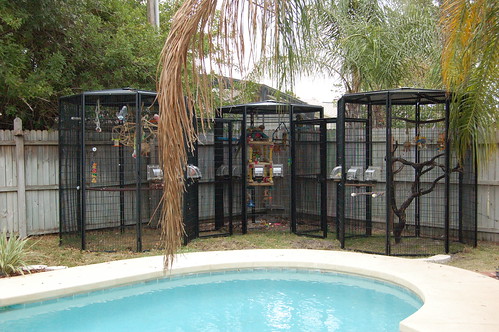
Your parrot’s feathers speak to its overall health. A healthy parrot will have soft, vibrant and well-formed feathers. Flaws in the feathering, such as discoloration are often a sign of poor diet or the lack of sunlight, but can also be attributed to illness and the subsequent use of antibiotics. It can also signal serious organ problems or PBFD. If you have noticed a change in your parrots feathering, you should seek the attention of an avian certified vet to rule out any significant health issues.
A good, varied diet containing all of the necessary vitamins and minerals, fresh air and sunlight is your first, and best, line of defense. The use of full spectrum lighting, where sunlight is not available, is recommended. Feather discoloration is a symptom of underlying problem, whether it be nutritional or environmental.
Vitamin A:
Vitamin A is said to be the biggest nutritional deficit our parrots face in captivity. A vitamin A deficiency (hypovitaminosis A) can be trouble for your parrot. It lowers the immune system and can cause lethargy, affecting eating habits, resulting in low body weight. It can cause respiratory problems producing sneezing, wheezing and nasal discharge. It can affect the function of the liver, thyroid, adrenal or pituitary glands. And it affects the coloring in the feathers.

If some of your parrot’s feathers are dramatically lighter in color, or have black tips or edges, a vitamin A deficiency could be the cause. If caught early, it is rectifiable. If caught too late, it can diminish the length and quality of your bird’s life. At very least, a long standing, unresolved deficiency in vitamin A will require long term medical care. Amazon owners should take care to see that their parrots eat a diet rich in vitamin A, as they are in a high risk category for hypovitaminosis A.
Some foods that are high in vitamin A include carrots, sweet potato, kale, spinach, red pepper, mangoes, and apricots. Try sprinkling a little chili powder or paprika, both containing vitamin A, over vegetables for a little added boost and change of pace.
Dandelion leaves are a rich source of vitamin A (as well as B, C, E – also high in potassium and calcium), an all-round great green to add to your parrot’s diet and your own. Please be very careful to pick these leaves from areas that have not been sprayed with pesticides – when in doubt – don’t!
Vitamin D3/sunlight:
The sun’s ultraviolet rays, or the near UV range in your full spectrum lighting, help your bird’s body to synthesize vitamin D3, with the assistance of oils from the preen gland, ultimately effecting the condition and coloration of its feathers. The companion parrots you see with the most vibrant colors are always the ones with access to the best lighting. Vitamin D3 helps to metabolize minerals and aids in calcium absorption. It stimulates the immune system. An additional benefit to sunlight is its ability to kill bacteria on the feathers.
Strangely, there are few sources of food that are high in Vitamin D. Canned pink salmon and organic egg yolk are a couple that are suitable for parrots. There are some cereals that are fortified with vitamin D, but most contain sugars and salt. So sunlight it is!

If you have the means to provide your parrot with an outdoor aviary, this should be high up on your to-do list. If you have the space but can’t afford to buy one, you can pour a concrete slab and erect some poles and make one. It will give your bird the vital natural sunlight and fresh air it needs, and an advantage where his health is concerned. It will allow him to reconnect with nature in a safe environment and allow him to be the bird he is – for at least part of the year.
Environmental:
What goes on the feathers needs to be considered as carefully as what goes into them. Toxins like cigarette smoke, oils from cooking or even residue from your hand lotions can affect the quality and coloration of your parrot’s feathers. I have an Austin Allergy Jr HEPA filter running 24/7 in my house. This picks up many particulates, oils or gasses in the air. If I have been touching any chemicals or cleaning products, I wash my hands well before I handle my birds.
It’s really simple. Don’t allow anything on your bird’s feathers that doesn’t belong there.

Supplements/pellets:
I am not a big fan of putting vitamins in the bird’s water or over food on an every day basis. I feel that if your parrot is eating the proper varieties of food, this should be enough. Vitamins work in conjunction with food. If your parrot isn’t eating the foods that the vitamins are there to enhance, the vitamins aren’t able to do their job. If your parrot IS eating well, the inclusion of these extra vitamins can lead to vitamin toxicity or hypervitaminosis. This is a topic for discussion with your vet. If there is an area where there is a clear need, a supplemental vitamin might be recommended.
Pelleted diets will help cover for deficiencies left by the bird who doesn’t eat vegetables and fruits reliably and can pick up some the slack to a degree. Pellets, however are just a base to your parrot’s overall diet and cannot get the job done on their own. A parrot that survives on pellets alone might be looking at liver problems in his future.
Author Patty Jourgensen specializes in avian health, behavior and nutrition and has been working with and caring for rescue birds since 1987.



2 comments
Attadale King parrot dark feathers under and very thin.
Thank you for this article your knowledge and experience are quite admirable. Much appreciated be healthy be safe. Respectfully, K. Tafoya
Leave a comment